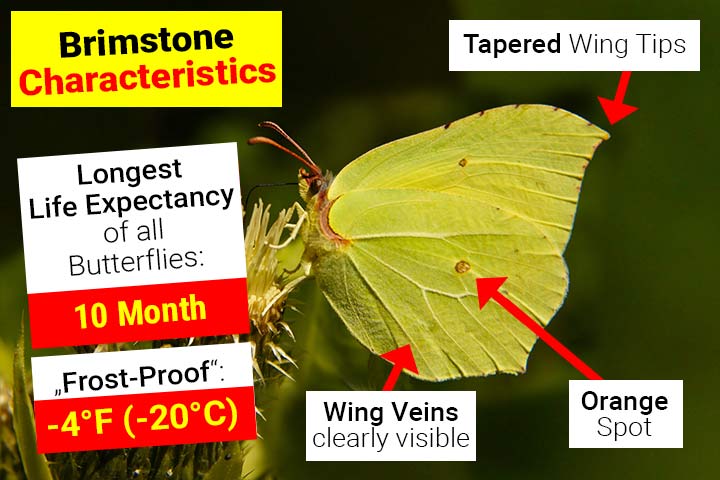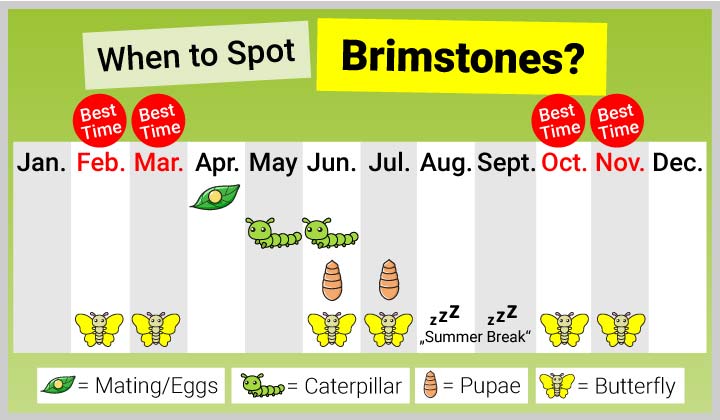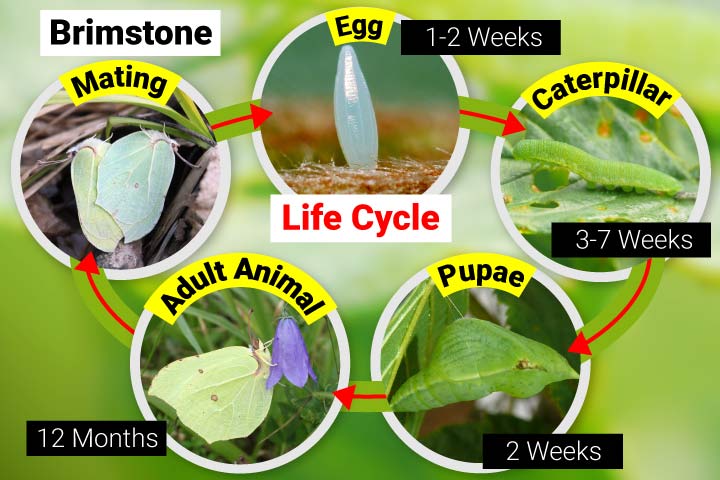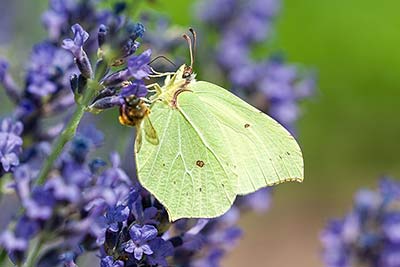Brimstone Butterfly
Brimstone Butterfly Facts
| Size | 1.9-2.9 inches (50-74 mm) (wingspan) |
| Speed | Unknown |
| Weight | Unknown |
| Lifespan | 11-12 months |
| Food | Nectar |
| Predators | Birds, wasps |
| Distribution | Europe, Africa, Asia |
| Habitat | Forests, meadows, parks, gardens |
| Order | Butterflies |
| Family | Pieridae |
| Scientific name | Gonepteryx rhamni |
| Characteristics | Yellow color; first butterfly to be seen in spring |
Main Characteristics
The brimstone butterfly is one of the first butterflies to be seen in spring. Its bright yellow color makes it easy to identify. Apart from the color, its most striking features are the leaf-shaped wings. It also has distinctive orange dots on the tops of its wings. Of all the butterflies in the world, the brimstone butterfly has the longest lifespan: 12 months!

Habitat
Brimstone butterflies are widespread in Europe, Africa, and Asia. They are not particularly picky about their habitat. They like wet or dry areas, meadows and forests. Their top priority is flowers and sunshine.
Name
The term “butterfly” goes back to the brimstone. Butterfly contains the word “butter”, which usually has a strong, yellow color. They used to be called “butter-colored flies”. Over time, the term “colored” was shortened.
Life Style
Brimstone butterflies are diurnal. They're the first to be seen in the still quite cool and fresh days of spring. They spend their time looking for a mate and beautiful flowers. When they rest, they tuck in their wings. On chilly days they angle their wings towards the sun to soak up as much warmth as they can.

Anatomy and Appearance
Size
The brimstone butterfly is a rather large butterfly with large leaf-shaped wings. Its wingspan is 1.9-2.9 inches (50-74 mm).
Color
The brimstone butterfly was named after the males because they are bright yellow. The females are rather pale, yellow-green, sometimes even almost white. Both have a small orange spot on the tops of their wings. However, it is rarely seen because the butterfly usually folds its wings. On the underside the spots look reddish-brown.
Caterpillars
The brimstone butterfly caterpillars are green, making it difficult to tell them apart from fresh, green leaves.
Brimstone or Large White Butterfly – What’s the Difference?
The brimstone is often mistaken for the large white butterfly. However, they can be easily distinguished due to the shape of the wings and the color of their spots. The brimstone has tapered wings. They look very similar to leaves. The wing tips of the large white are rounded. The large white also has large black spots on its wings. In the brimstone they're orange (top side) or reddish brown (bottom side).

Diet
Brimstone butterflies feed on nectar. They love red and purple flowers. They're particularly often seen on thistles, lilacs, widow flowers and knapweed. The caterpillars have a preference for specific food plants and primarily consume the leaves of shrubby plants - especially buckthorn.
Behavior
Torpor
Brimstone butterflies look delicate and fragile. But they are surprisingly tough. In winter, many species of butterflies seek shelter in frost-proof caves. The brimstone is the only Central European butterfly to overwinter almost unprotected - it simply hangs on the underside of leaves, in ivy or grass. Its winter torpor lasts a total of seven months.

Senses and Abilities
Frost Protection
Brimstone butterflies are equipped with a built-in frost protection system. The glycerin in their bodies prevents them from freezing, enabling them to survive temperatures as low as minus 4 degrees Fahrenheit (minus 20 degrees Celsius).
Senses
For many butterflies, the sense of smell is the most important. The color of the flowers plays a significant role in guiding brimstone butterflies, making their sense of sight crucial for navigation.
Are Brimstones Poisonous?
Neither the caterpillars nor the adults are poisonous.
When Can You See Brimstone Butterflies?
The best time to see brimstone butterflies is between February and March and between October and November. They're not very active in summer because it is too hot for them. Their caterpillars can be seen between May and June.

How to Attract Brimstone Butterflies
This is quite simple! The brimstone butterflies' favorite plant is the buckthorn. While the insect isn't picky about its food, it only sticks its eggs on the leaves of the buckthorn tree. So if you have a garden, you can just plant one. But be careful: the berries, leaves and fresh bark are considered poisonous.
Life Expectancy
The brimstone is the butterfly with the longest life expectancy. It lives up to 12 months.
Enemies and Threats
The brimstone's natural enemies include birds and wasps. It isn't considered an endangered species, but it suffers from loss of habitat and pesticides.
Importance for the Ecosystem
Brimstone butterflies are very important to the ecosystem. While most insects are still in torpor, they're already flying from flower to flower.
Reproduction
Mating
Brimstone butterflies mate in spring, usually in April. The mating ritual involves females and males circling each other and flying high up towards the sky.
Caterpillars
After mating, the female sticks up to 100 eggs under the buckthorn leaves. It takes one to two weeks for the caterpillars to hatch. They go through several stages of development within 3-7 weeks. Then they pupate for two weeks. The adults emerge in June. However, they are less active during the hot summer period. As soon as it gets a little cooler again, you'll see them more often again. They remain active until autumn and then fall into torpor. Next spring they wake up again.
Duration of development/phase:
- Egg: 1-2 weeks
- Caterpillar: 3-7 weeks
- Pupae: 2 weeks
- Adult animal: 12 months

The Brimstone Butterfly Is Related To:
- Orange Tip
- Large White
Animals in the Same Biome:
- Blue Tit
- Eurasian Chaffinch
- Eurasian Goshawk
- European Hare
- European Pied Flycatcher
- Microbat
- Mouse
- Rabbit
- Red Fox
- Spider
- Deer
- Yellowhammer
Related Articles:












